A Journey Through Time: Explore Ancient Jewish Life in Khirbet Midras
Looking for an adventure combining nature, scenery, and rich Jewish heritage? Discover Khirbet Midras, an ancient Jewish village near Beit Shemesh.
 View from Khirbet Midras (Photo: RG in TLV cc sa by)
View from Khirbet Midras (Photo: RG in TLV cc sa by)What defines a Jewish settlement today?
A synagogue and a mikvah, right?
You can find both at Khirbet Midras, an ancient Jewish village located south of Beit Shemesh.
One clear day, my car took me to this place. The journey to Midras is in itself a pleasant trip, winding gently through tree groves, vineyards, and green fields. From the parking area, I climbed a marked trail to the top of a small hill, surrounded by breathtaking views as far as the eye can see. Suddenly, I found myself two thousand years back in time, among the homes of an ancient Jewish settlement.
Khirbet Midras was inhabited from the time of the Second Temple until the Bar Kokhba revolt. After being studied by archaeologists, part of it was reconstructed, and the result is truly impressive. An ancient document was uncovered here with the name Midras, leading researchers to identify the site with a Jewish village mentioned in ancient writings as "Kfar Atrah" in this area. The site is equipped for visitors, with wide paths and signage. The fresh air and colorful blossoms on the surrounding hills enhance the enjoyment of the place.
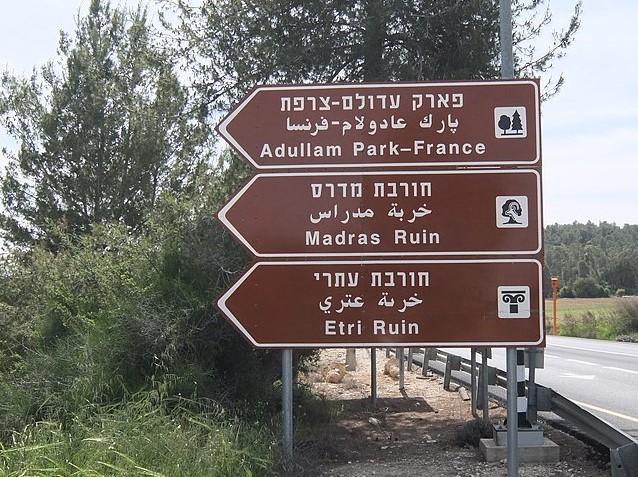 Signage to Khirbet Midras (Photo: Davidbena cc sa by)
Signage to Khirbet Midras (Photo: Davidbena cc sa by)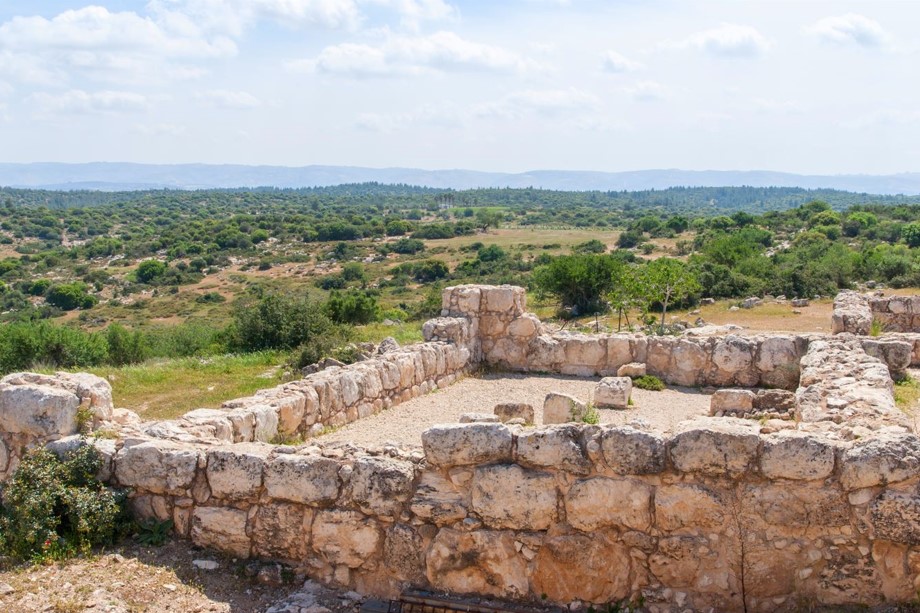 The synagogue at Khirbet Midras (Photo: Rivka Lebron)
The synagogue at Khirbet Midras (Photo: Rivka Lebron)In Midras, you cannot help but feel the rich Jewish history steeped in the location. I entered the large synagogue of the village with a sense of reverence (marked by sign No. 7). It is moving to see it built according to halacha: facing towards Jerusalem, with an entrance hall to allow worshippers to pause before entering the sanctuary. On the synagogue's floor are the bases of carved pillars that adorned it, unlike the village's other sturdy yet unadorned houses. This follows the Jewish custom of beautifying the synagogue more than residential homes. As Maimonides wrote, "If you build a house of prayer, it should be more beautiful than your dwelling."
I left the synagogue and found two courtyards adjacent to it, one with a long stone bench to sit on. It turns out these courtyards were used by worshippers for activities like sitting in the sukkah, joyous events, and gatherings, as is still customary today.
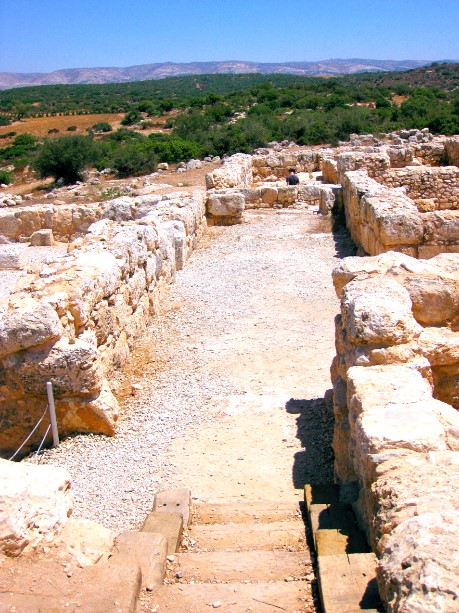 The vestibule of the synagogue (Photo: Rivka Lebron)
The vestibule of the synagogue (Photo: Rivka Lebron)Four mikvahs were discovered at Midras, and I descended into their cool, dim interiors via comfortably hewn rock steps. Two are near the synagogue entrance and seemed to serve worshippers for immersion, just as they still do today.
Undoubtedly, the synagogue and mikvahs are a testament to the observant Jewish community that once lived here.
Yet, the village also saw hard times.
In a corner of the synagogue, I spotted an underground opening leading to a tunnel extending to a hidden spot outside the village. This was an emergency escape tunnel, installed by the residents of Midras during the Bar Kokhba revolt. About 20 such tunnels were found in the area, used for hiding residents and Jewish fighters from Roman soldiers. Villagers carved them beneath their homes' floors, including the synagogue, to quickly descend into hiding when the enemy approached.
The tunnel entrances can be seen in the corners of homes, and you can descend into one (not during the rainy season) with a flashlight – a fitting adventure for children, and adults with a taste for adventure.
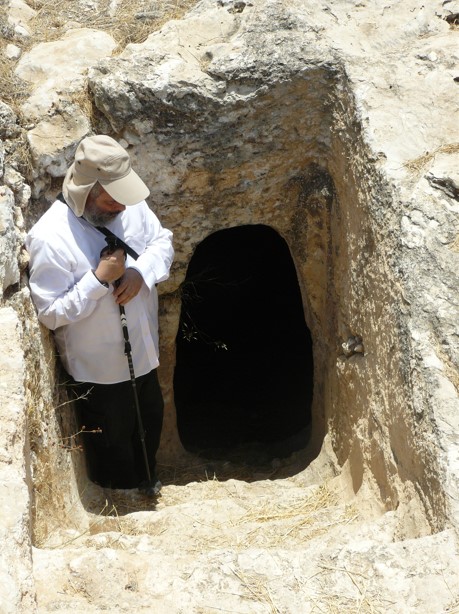 The author at the entrance of a mikvah in Midras (Photo: Rivka Lebron)
The author at the entrance of a mikvah in Midras (Photo: Rivka Lebron)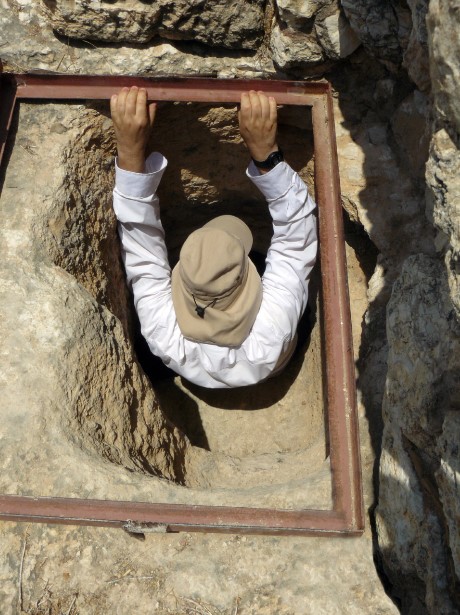 Entering a hiding tunnel in Khirbet Midras (Photo: Rivka Lebron)
Entering a hiding tunnel in Khirbet Midras (Photo: Rivka Lebron)Another hiding tunnel, located further up the path leading to the village, was converted into a Roman burial cave after the Bar Kokhba revolt was suppressed. Today, it is called "Cave of Reliefs," and those interested (and who are not Kohanim) can enter and admire the large rooms hewn from the bedrock.
Other intriguing features of Midras include large underground storage rooms accessed by iron rungs and staircases – a thrilling experience for kids. At the end of the village is a large winepress, used for pressing grapes harvested from the abundant vineyards on the fertile surrounding hills.
Khirbet Midras is a fairly quiet spot, without many visitors. There are trees under which you can sit, relax, enjoy the panoramic views surrounding the site, and reflect on our unique people, who have clung to their faith for thousands of years and overcome all who sought to do them harm.
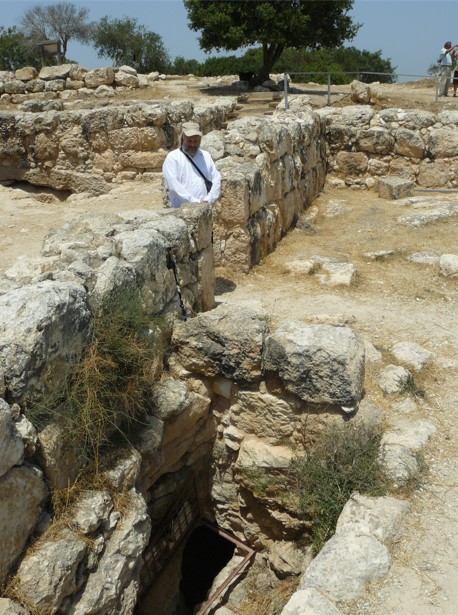 The author at the synagogue entrance in Midras, looking at the escape tunnel entrance (Photo: Rivka Lebron)
The author at the synagogue entrance in Midras, looking at the escape tunnel entrance (Photo: Rivka Lebron)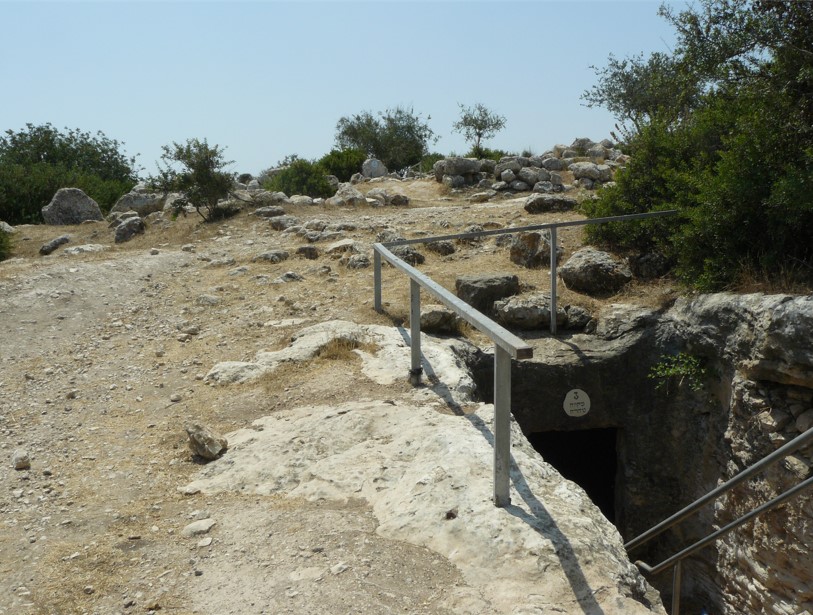 Entrance to a large mikvah in Khirbet Midras (Photo: Rivka Lebron)
Entrance to a large mikvah in Khirbet Midras (Photo: Rivka Lebron)Recommended Season: All year.
Duration: 1-2 hours.
Route Type: Circular.
How to Get There: By car only. Midras is in Park Adullam-France, accessible from road 38. Waze: "Khirbet Midras". Follow the paved park roads with signs leading to the site.
Parking: Abundant and free.
Entrance Fee: None.
Difficulty and Accessibility: Easy. A 10-minute walk on a gently ascending trail. Not stroller-friendly.
Water: Drinking fountains available in nearby Park Adullam-France.
Restrooms: At the gas station at Tzomet HaEla.
Security: The site is within the Green Line, with no Arab villages nearby.
More Attractions Nearby: Khirbet Burgin, Khirbet Midras.
Sources are from Rabbi Zamir Cohen's book, "Biblical Archaeology," Volume VI, Page 229.
Nissan Lebron is the editor of Rabbi Zamir Cohen's "Biblical Archaeology" series

